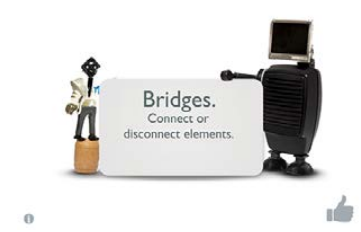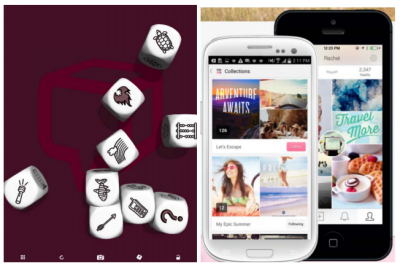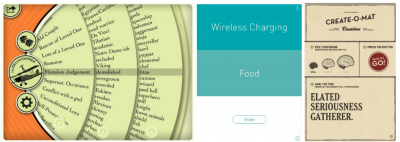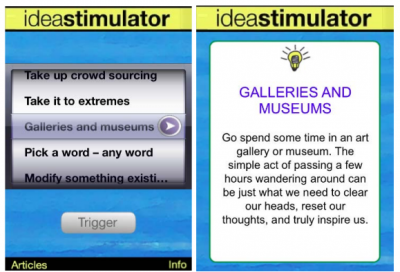Combination of Different Concepts/OG
| Combination of Different Concepts | |
| Contributors | Christian Kohls |
|---|---|
| Last modification | May 17, 2017 |
| Source | Kohls (2015)[1] |
| Pattern formats | OPR Alexandrian |
| Usability | |
| Learning domain | |
| Stakeholders | |
Context
We are very good in learning categories and concepts. To quickly recognize and to respond to patterns is required for survival. We need to identify danger situations, we need to act in social contexts appropriately and we need concepts for communication. This sort of analytical thinking gives us confidence and reliability.
Problem
But linear and analytical thinking will not lead to new forms. Once you learned a concept you will continue to think within the constraints of the existing concept. Our fixation on common behaviors and associations is dangerous when we need to adapt to new situations and need to truly innovate. How can we break up existing concepts?
Forces
If we think within one concept we will only come up with variations of it. If we think about designing a new table we may come up with millions of different tables yet they will all resemble the concept of a table. We need to release our thoughts from the common concept.
Changes in our environment and access to new information and new knowledge often require new solutions – what worked yesterday does no longer work in today’s world.
Our brain is always trying to recognize patterns. Even if we present random structures to it, the brain will try to recognize a meaningful form.
Solution
Therefore, systematically find new solutions by blending and combining existing concepts into new solutions. Draw concepts from your current problem space, from your domain and from very remote fields. Make new connections between the concepts by analyzing their commonalities, dissimilarities and relations.
- Take two (or more) existing concepts. One concept could be an existing solution or an idea that needs further development. The second concept should be taken from another domain.
- The second concept could be chosen randomly or it could be a similar concept from another domain (e.g. if you want to improve packaging of cereals, consider how books are packaged).
- Try to combine the two concepts and think about a new product of them. The rationale behind this approach is that our mind always tries to find a stable pattern of imagination[2][3].
- Write down all properties of each concept. How can the properties of one concept be transferred to the other concept?
- Divide your design into parts. Think for each part whether it can be replaced or combined with something from the other concept.
You can combine two or more ideas to a new idea. You could also steal from other ideas to improve your design. As long as you not simply copy an idea but combine it into something new you will create original work.
Example
Five examples of combining concepts:
- Combine different concepts from your problem space (i.e. first analyse your concepts into whole parts, then combine the parts that seem to be unrelated at first sight).
- Combining concepts from your problem space with completely unrelated concepts (i.e. use one of the key concepts of your problem or solution space and combine it with a very remote concept).
- Pick up two or three concepts at random. Force yourself to think about potential relations between these concepts and your problem field.
- Choose a random word. How does it relate to your problem? Could the concept behind the word improve your existing solution or idea?
- Go to the mall or to the museum. Look at the objects you find there. Could you learn anything from them for your current problem?
Supporting Tools
Consequences
Many creative ideas are actually combinations of existing concepts, very often from dissimilar subjects. New innovative products come from studying solutions in nature and trying to copy the natural solution with technology.
Meaning emerges from context and form. Put a form in different environments and it will have different meanings. Likewise meaning changes when we combine concepts – this is like a chemical reaction where two or more substances create something new altogether.
In nature the mixture of forces will generate patterns. We can blend dissimilar subjects to force the formation of new patterns and generate new concepts[3].
References
- ↑ Kohls, C. (2015). Patterns for creative thinking: idea generation. In Proceedings of the 20th European Conference on Pattern Languages of Programs (EuroPLoP 2015) (p. 30). New York:ACM.
- ↑ De Bono, E. (1990). Lateral Thinking. London: Penguin Books.
- ↑ 3.0 3.1 Michalko, M. (2006). Thinkertoys: A handbook of creative-thinking techniques. Berkeley, Calif: Ten Speed.



